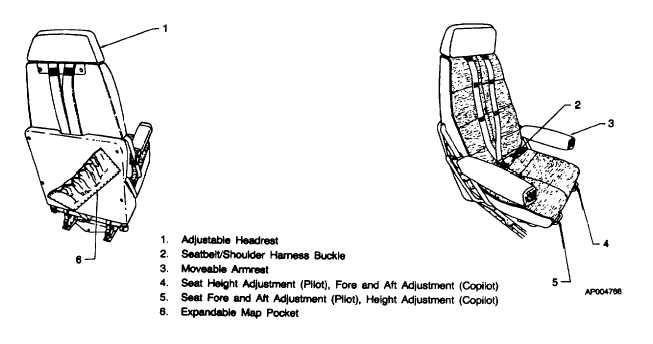TM 55-1510-219-10
2-11. WINDOWS.
a.
Cockpit Windows. The pilot and copilot have
side windows, a windshield and storm windows, which
provide visibility from the cockpit. The storm windows
may be opened on the ground or during unpressurized
flight.
b.
Cabin Windows. The outer cabin windows, of two-
ply construction, are the pressure type and are integral
parts of the pressure vessel. All cabin windows are
painted over except for the two small aft windows
(movable curtains are provided to cover these windows
when it is desited to seal out light).
2-12. SEATS.
a.
Pilot and Copilot Seats. The pilot and copilot
seats (fig. 2-8) are separated from the cabin by
movable curtains. The controls for vertical height
adjustment and fore and aft travel are located under
each seat. The fore and aft adjustment handle is
located beneath the bottom front inboard corner of each
seat. Pulling up on the handle allows the seat to move
fore or aft. The height adjustment handle is located
beneath the bottom front outboard corner of
each seat. Pulling up on the handle, allows the seat to
move up and down. Both seats have adjustable
headrests and armrests which will raise and lower for
access to the cockpit. Handholds on either side of the
overhead panels and a fold-away protective pedestal
step are provided for pilot and copilot entry into the
cockpit (fig. 2-9). For the storage of maps and the
operator's manual, pilot and copilot seats have an
inboard-slanted, expandable pocket affixed to the lower
portion of the seat back. Pocket openings are held
closed by shock cord tension.
b.
Pilot and Copilot Seat Belts and Shoulder
Harnesses. Each pilot and copilot seat is equipped with
a lap-type seat belt and shoulder harness connected to
an inertia reel. The shoulder harness belt is of the "Y"
configuration with the single strap being contained in an
inertia reel attached to the base of the seatback. The
two straps are worn with one strap over each shoulder
and fastened by metal loops into the seat belt buckle.
The spring loading at the inertia reel keeps the harness
snug but will allow normal movement required during
flight operations.
The inertia reel is designed with a locking device that
will secure the harness in the event of sudden forward
movement or an impact action.
Figure 2-8. Pilot and Copilot Seats
2-18

